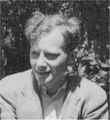Template:Selected anniversaries/November 11: Difference between revisions
Jump to navigation
Jump to search
No edit summary |
No edit summary |
||
| Line 19: | Line 19: | ||
File:Henry Whitehead.jpg|link=J. H. C. Whitehead (nonfiction)|1904: Mathematician and academic [[J. H. C. Whitehead (nonfiction)|J. H. C. Whitehead]] born. During the Second World War, he will work with the codebreakers at Bletchley Park. | File:Henry Whitehead.jpg|link=J. H. C. Whitehead (nonfiction)|1904: Mathematician and academic [[J. H. C. Whitehead (nonfiction)|J. H. C. Whitehead]] born. During the Second World War, he will work with the codebreakers at Bletchley Park. | ||
||Georg Aumann (b. November 11, 1906), was a German mathematician. He was known for his work in general topology and regulated functions. During World War II, he worked as part of a group of five mathematicians, recruited by Wilhelm Fenner, and which included Ernst Witt, Georg Aumann, Alexander Aigner, Oswald Teichmueller and Johann Friedrich Schultze, and lead by Wolfgang Franz, to form the backbone of the new mathematical research department in the late 1930s, which would eventually be called: Section IVc of Cipher Department of the High Command of the Wehrmacht (abbr. OKW/Chi). He also worked as a cryptanalyst, on the initial breaking of the most difficult cyphers. He also researched and developed cryptography theory. Pic. | |||
||Enzo Martinelli (b. 11 November 1911) was an Italian mathematician, working in the theory of functions of several complex variables: he is best known for his work on the theory of integral representations for holomorphic functions of several variables, notably for discovering the Bochner–Martinelli formula in 1938, and for his work in the theory of multi-dimensional residues. | ||Enzo Martinelli (b. 11 November 1911) was an Italian mathematician, working in the theory of functions of several complex variables: he is best known for his work on the theory of integral representations for holomorphic functions of several variables, notably for discovering the Bochner–Martinelli formula in 1938, and for his work in the theory of multi-dimensional residues. | ||
Revision as of 13:10, 2 February 2018
1675: Mathematician Gottfried Leibniz demonstrates integral calculus for the first time to find the area under the graph of y = ƒ(x).
1875: Astronomer Vesto Melvin Slipher born. He will perform the first measurements of radial velocities for galaxies, providing the empirical basis for the expansion of the universe.
1904: Mathematician and academic J. H. C. Whitehead born. During the Second World War, he will work with the codebreakers at Bletchley Park.
1930: Physicist Hugh Everett III born. He will propose the many-worlds interpretation (MWI) of quantum physics.
1933: Cantor Parabola warns that crimes against mathematical constants are on the rise.
2005: The Venus Express successfully performs its first trajectory correction maneuver.





